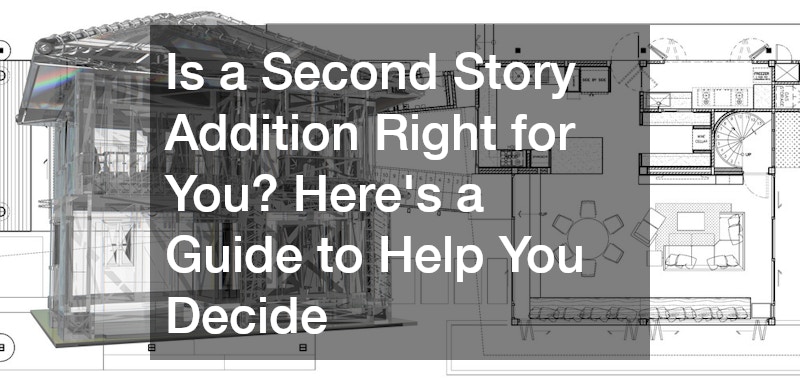
A second-story addition can be an exciting opportunity to expand your living space, increase the value of your home, and accommodate a growing family. However, such a significant renovation requires careful planning, consideration of costs, and understanding of the challenges involved. Whether you’re looking to double the size of your home or simply add a couple of extra rooms, here are the key factors to consider when deciding if a second-story addition is right for you.
When Does a Second Story Addition Make Sense?
Before diving into the details, you must first assess whether adding a second story makes sense for your home. The decision often depends on factors such as lot size, city planning regulations, and how much additional space you need.
Lot Size:
For homes on smaller lots, going upward instead of outward can be more practical. If you’re limited by space or want to preserve your yard, garden, or outdoor entertainment area, a second-story addition can be an excellent way to expand your home without sacrificing your outdoor space.
Setback Constraints:
City regulations often dictate how far you can build outward from the property line. In cases where setback constraints are too tight, adding a second story can be the best solution to gain more living space without violating local zoning codes.
Interior Flow:
Another consideration is how the addition will integrate with the existing layout of your home. For many homeowners, a second-story addition connected by a stairway can feel more natural than extending the home horizontally with a wing. If done thoughtfully, it can create a more cohesive interior flow.
Structural and Planning Considerations
Once you’ve determined that adding a second story is a feasible option for your home, it’s essential to examine a few critical structural and planning requirements. These involve understanding both city planning regulations and engineering considerations.
City Planning Requirements:
Begin by researching the city’s height restrictions for homes in your area. A simple way to do this is by observing neighboring houses. If there are homes nearby that are as tall as you’d like yours to be, chances are you’ll be within city limits. You can also contact your local planning office to verify the exact height requirements for your neighborhood.
Engineering Challenges:
When adding a second story, the structural integrity of your home is paramount. This involves two main types of loads: gravity and lateral loads.
Gravity Loads:
These refer to the weight-bearing capacity of your home’s foundation. Homes built before the 1940s may not have footings at all, which can complicate the process. In such cases, additional support structures like new footings in the crawl space or basement may need to be added.
Lateral Loads:
These loads come from external forces like wind or earthquakes. Older homes may lack proper sheathing, which helps prevent the house from collapsing sideways. For homes without adequate sheathing, the walls may need to be reinforced with plywood and other materials to ensure stability.
Types of Second-Story Additions
There are three main types of second-story additions, each with its own pros and cons. The choice between them depends on how much extra space you need and how involved you want the renovation to be.
Dormer Addition:
A dormer is a small extension that projects from an existing roofline, providing additional space and architectural interest without dramatically altering the home’s structure. While dormer additions are typically less complex and don’t require significant changes to the foundation, the usable space gained may be limited. Incorporating features like centre pivot roof windows can make a dormer addition feel more spacious and inviting by maximizing natural light and ventilation, making the smaller area more functional and comfortable.
Partial Second-Story Addition:
In this type of addition, a portion of the existing roof is removed, and a new second story is added to part of the home. This is ideal if you need additional space for a couple of bedrooms or a bonus room but don’t require a full second-story expansion. While this option provides more space than a dormer, it’s still less invasive and costly than a full second-story addition.
Full Second-Story Addition:
For homeowners looking to double the size of their home or add multiple bedrooms, bathrooms, and perhaps even a master suite, a full second-story addition is the way to go. This type of renovation involves removing the entire roof and adding a completely new second level. It’s a significant project that often includes reconfiguring the first floor to accommodate the new layout, making it ideal for those planning an extensive home renovation.
Costs of Adding a Second Story
The cost of a second-story addition varies significantly based on the type of project, the size of the addition, and the complexity of the engineering work required.
Dormer Additions:
The cost of a dormer addition can range from $75,000 to $200,000, depending on the size and scope of the project. While it’s the least expensive option, the limited additional space may not make it worth the investment for some homeowners.
Partial Second-Story Additions:
Partial additions generally start around $250,000 and can go up to $400,000 or more. Factors that influence the cost include whether or not you’re adding bathrooms, how large the new space is, and the extent of the necessary structural work.
Full Second-Story Additions:
A full second-story addition is the most expensive option, with costs typically starting around $400,000 and going upward from there. This price reflects the complexity of removing the existing roof, adding new structural support, and potentially reconfiguring the first-floor layout. Additionally, second-story additions are usually more expensive than expanding outward on the ground floor.
Project Timeline
A second-story addition is a significant investment, both in terms of money and time. The design phase can take three to five months, while permitting can last anywhere from one to six months, depending on your local jurisdiction. The construction process itself can take between five and nine months, depending on the scale of the project. Therefore, homeowners should expect the entire process—from initial design to completion—to take about a year or more.
Final Thoughts
Adding a second story to your home is a major undertaking, but it can provide much-needed space and dramatically increase your home’s value. By understanding the costs, structural requirements, and potential timelines involved, you can make an informed decision about whether this type of renovation is right for you.
.




